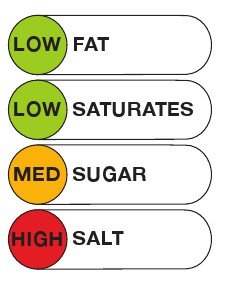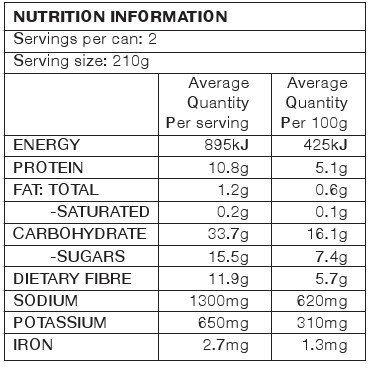As New Zealand policy-makers examine ways to help consumers make healthy food choices, a new Otago study has shown that keeping it simple works best.

Researchers at Otago University have shown that a front-of-pack ‘Traffic Light system’ (see image) using a red-yellow-green colour code for high, medium and low salt content helps consumers make healthy choices.
The full study, published in the journal Public Health Nutrition, is available to registered journalists in our Resource Library.
Last year the traffic light labelling system was recommended to a trans-Tasman food regulation forum by an expert review panel. The forum agreed that a standardised, easy-to-undertand front-of-pack nutrition label should be introduced – and now aims to have one in place by the end of the year. See more below.
It is estimated that consumers typically spend between four and ten seconds choosing a product in a supermarket.
The SMC contacted New Zealand experts for further comment on the research. Feel free to use these quotes in your reporting. To talk to one of these experts, please contact the SMC (04 4995476; smc@sciencemediacentre.co.nz).
Dr Racheal McLean, a Research Fellow at the Edgar National Centre for Diabetes research, University of Otago, explained the study to the Science Media Centre:
“Reducing dietary salt intake is an important way to reduce blood pressure and risk of heart disease and stroke, especially if it is done across the whole population. New Zealanders, on average, consume more salt than is recommended by dietary guidelines, as do people in most countries around the world. In a western style diet, around three quarters of salt consumed is already in processed foods, with only around 10% added at home- in cooking or at the table.
“Ensuring that consumers are able to identify the amount of salt in processed food is vital if people are going to regulate their own intake. Food labelling is an important tool, as many products that are high in salt do not necessarily taste salty.

“Our research tested New Zealand consumers’ ability to use a range of currently available food labelling formats to discriminate between products when grocery shopping. We used a large national online panel to simulate in-store behaviour. We tested the Nutrition Information Panel (mandatory in New Zealand since 2002), two front of pack labels: the Percentage Daily Intake label used voluntarily by several food manufacturers in New Zealand, and the Traffic Light Label which has been in use as a voluntary system in the United Kingdom for a number of years. We also tested the ‘low salt’ and ‘reduced salt’ nutrition claims currently in use in New Zealand in combination with the various labels.

“The results showed that both front-of-pack labels (percentage daily intake and traffic light labels) enabled people to better identify products with high and low salt content, however the traffic light label enabled them to do this more effectively. In particular, the traffic light label enabled people to identify the high-salt product more easily. The traffic light label also performed better than the percent daily intake label in enabling people to identify high and low salt products when they were faced with products labeled with a ‘reduced salt’ nutrition claim.
“We believe that the simple colour coded message of the traffic light makes them easier to understand than the more detailed information in the other labels tested.
“These findings are consistent with international research that shows that people find simple colour coded food labels such as the traffic light allow them to easily identify more healthy foods across a range of nutrients. Traffic light labels, if widely implemented, could be a useful tool to improve nutrition in New Zealand.
Prof Elaine Rush, Professor of Nutrition, AUT, commented:
“This report provides evidence that a front-of-pack traffic light labeling system is more effective than other labelling systems in allowing normo – and hypertensive consumers to discriminate between high and low sodium foods, even in the presence of misleading nutrition claims on the label. Those with known (self-reported) hypertension were more likely to have been advised to reduce the salt in their diet, read nutrition labels and choose a product with front of pack traffic light labelling that identified the product as low sodium.
“This evidence adds to the understanding of the effectiveness of clear front of pack labelling and supports its use. The simplicity of three colours (red, amber, green) and four nutrients (fat, saturates, sugar and salt) is attractive but has a number of detractors.
“It is nutrient-based and does not give a rating to the whole food. The nutrients profiled are considered “bad” – what about the good ones – like fibre, protein and fruit and vegetable content – they should be shown too. (Water would be a perfect food based on this system- low in salt, sugar and fat – but where are vitamins and minerals and macronutrients?) It is not black and white,
“People eat foods not nutrients. Foods make up meals. Dietary advice should be in context. Once a condition is diagnosed and linked with a nutrient e.g. high blood pressure with salt, diabetes with sugar, obesity with fat, heart disease with saturates, then the importance o the overall nutritional quality of the diet and foods eaten may be lost.
“In New Zealand we have food based dietary guidelines for different ages and stages which guide the choice of foods – not nutrients.
“Front of pack labelling such as:
- Watties with the number of vegetable serves in a can,
- Sanitarium with their healthy eating system with gives dietary advice such as eat often, eat occasionally and eat sparingly, and
- Ministry of Health (school) food-based classification system of everyday, sometimes and occasional foods
should also be considered
“Another consideration for many New Zealand people and families is cost.
“There is a need for better communication with consumers about the quality of foods – front of pack labelling is one important step as is robust evidence that the communication is effective.”
A green light for front-of-pack labelling?
A recent government-commissioned review of food labelling in New Zealand and Australia, Labelling Logic, found that “existing labelling requirements do not appear to have been adequate to encourage reformulations in line with healthy eating principles.”
The review supported front-of-pack nutritional labelling which provides a simple way to understand nutrition content, so that children and adults with low literacy and numeracy skills can make informed, healthy choices easily.
Specifically, the review recommended a traffic-light style system stating: “the colour-coded multiple traffic lights system has been consistently found to be most effective in facilitating consumers’ understanding of the nutrient profiles of foods within and across food categories”.
Although they stopped short of recommending mandatory traffic light labels for all food products, the review panel did suggest that such a label be required for all foods making nutritional claims such as, ‘low in salt’.
A trans-Tasman policy forum responding to the report agreed to the need for an easily understood, interpretive front-of-pack labelling system for packaged foods. In June the forum will provide a report on front-of pack-labelling, with the aim to implement a system by the end of 2012.